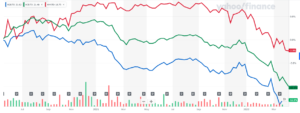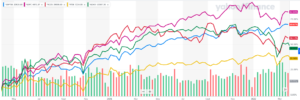Reblogged from Brintab
As the developed world navigated past the Omicron virus wave, various factors lengthened and/or accelerated the inflation we once hoped would be transitory. On the economic demand-growth side, various economies saw increased consumer activity, especially in leisure spending. On the economic supply-constraint side:
- Covid-induced supply chain issues only abated slightly,
- Since wage inflation has not kept up with price inflation, various strikes among unionized workers broke out. Also hiring employers found it tougher to find new recruits
- Russia’s invasion of Ukraine led to the escalation of various commodity inputs like grains, oil, natural gas, uranium, potash, and nickel.
At the end of the quarter there was a very slight counter-effect abating the inflation concern. In China the breakout of yet another Covid wave led to lockdown of varying degrees in several cities in March and into April which, for example, pushed back slightly on the rising price of oil.
Bonds and Interest Rates
Jerome Powell, head of the US Federal Reserve has been dogged by criticism that the timid Fed has not risen to the fight against inflation. In my opinion the original source of inflation was indeed transitory but since it did not get fixed expediently, various knock-on effects (like increased labour demands) have started to snowball, making it self-perpetuating. The Fed definitely changed gears this winter, and has come out strong in its determination to boost interest rates to finally throw cold water on an economy where inflation is getting uncomfortably high.
Back in January I talked about the likely challenging environment ahead for bond investors. If you look at how much bond prices have fallen this winter you can see just how much impact the change in Fed stance (with other central bankers like the Bank of Canada) has had. Although bonds had faded a bit in 2021, the decline in government bonds (blue line) and investment grade corporate bonds (green line) since January 2022 has been in the 8-10% ballpark. It is typical that a rise in interest rates (and fall in bond prices) of this magnitude foreshadows an economic recession typically 6-18 months down the road. It is often the time to consider more bond purchases since they have become relatively cheap.

Fig. 1: Bond ETFs: Gov’t (XGB), Corp (XCB), High Yield (XHY) – 2 years – Yahoo Finance
Currencies
This winter we can see that the US Dollar trended higher against a basket of currencies (green line) but it did not move much against the Canadian Dollar (blue line); it just bounced around. Why the two different experiences? Mainly Russia. Specifically, the Russian invasion of Ukraine boosted oil prices (good for the Canadian Dollar) and caused worry in other global economies that are more hurt than helped by rising commodity prices. And, of course when there is war the USD typically acts as a safe haven, pushing it higher. Layer onto that the fact that Canada’s strong housing market allowed the Bank of Canada to keep up with interest rate increases planned by the US Federal reserve and the result is a Canadian currency that more or less held up against the US Dollar.
Going forward the USD is likely to remain strong. As we edge into an economic recession down the road, likely by 2023, a leaning toward safe havens will tend to persist notwithstanding the likely recovery of the Euro as the impact of the Ukrainian war inevitably fades through military exhaustion. This means a USD likely maintaining its strength.

Fig. 2: US Dollar Index and Cdn Dollar vs USD – 2 years – Yahoo Finance
Stock Markets
This winter, after 2021’s long run higher in stocks, the market experienced the jitters typical of a later stage boom phase. The Russian invasion had the most impact on the German market (green line) while the Canadian market (blue line) was the most stable, largely due to the Russian invasion pushing Canadian commodity stocks higher.
Although Russia significantly impacted commodity stocks, with the Canadian market really feeling the impact, in the US stock market Russia was not the main driver. High tech stocks are a much more meaningful part of the US market than in Canada. The rising interest rate regime has had severe impact on tech stocks (as well as housing related stocks such as Home Depot). The newfound eagerness of the Fed to quash inflation has really doused the flames in high tech and in housing stocks.
Meanwhile, although Russia has accelerated the climb in commodity stocks, even without Russia it is common for commodity stock to rise up late in an economic cycle. We also see stabler (i.e. sometimes called defensive) sectors perform. Utility stocks such as Hydro One have held up well for us through the turbulence.

Fig. 3: Equities: US-purple, Can-blue, Jpn-red, UK-yellow, Germany-green – 2 yrs – Yahoo Finance
You might wonder, “With all this talk about ‘late-stage economy’, ‘recession’, etc. why don’t we just shift our stocks to cash and wait out the recession?” History shows that trying to time the market like this is a fundamentally bad idea. First of all, a substantial part of the stock market’s long-term performance tends to happen just before a recession. People who move to cash tend to miss those pre-recession returns. Then when a recession causes a pullback, even if there is a 15-20% decline from the new pre-recession high that they missed, these cash-sitters tend to re-enter the market after the recession at higher prices than their original exit! A truly bad outcome. Then what, you ask, is a wise strategy? When we buy stocks and bonds over time, our portfolio typically consists of a mix of great businesses bought at modest prices and moderate business bought at cheap prices. We are routinely reviewing the portfolio to see if those business are holding up to our expectations and/or getting too expensive given their long-term prospects. The result is the constant weeding of our investment garden, trying as best possible to maintain a crop of strong productive holdings, regardless of their short-term fluctuations. Now might be, as mentioned in the “Bonds” discussion above, the time when we see opportunity to channel more money into bond and income-oriented investments through the summer. Although this outcome seems likely, only through monitoring will we see which opportunities actually arise. Simply, that is what we do.
Respectfully submitted,
Paul Fettes, CFA, CFP
Chief Executive Officer,
Brintab Corp./Efficertain Corp.

Leave a Reply
You must be logged in to post a comment.